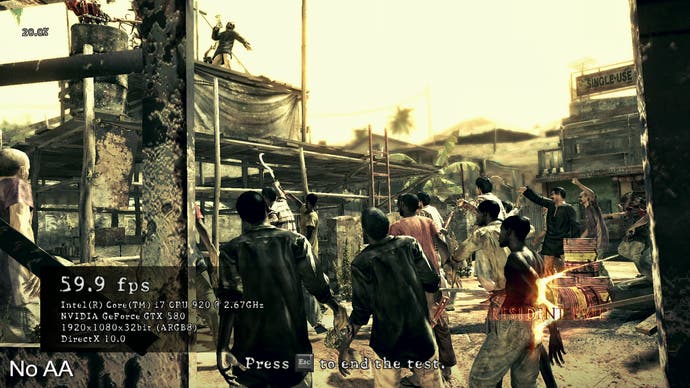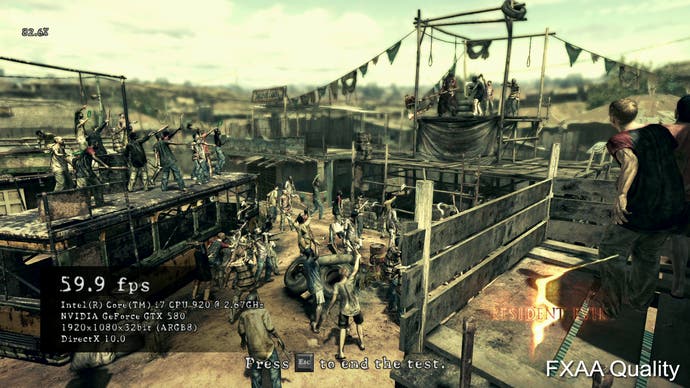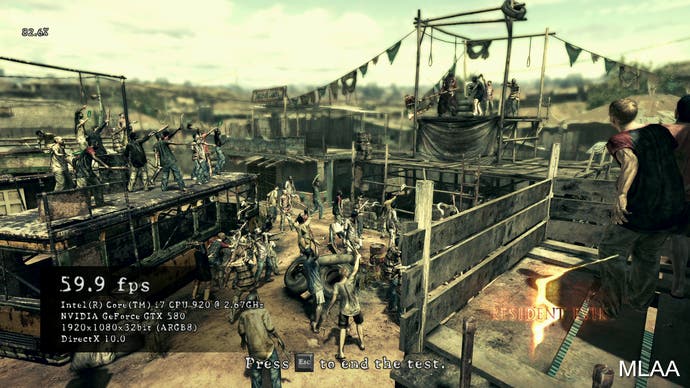Digital Foundry: The Future of Anti-Aliasing
Cutting edges.
Simply upping resolution in general goes a long way towards making post-process AA look nicer to the human eye. Looking forward to the next-gen (or the "now" if you're a PC owner), running the FXAA and MLAA filters on 1080p footage produces some outstanding results, and sub-pixel issues are far less noticeable.
"It's not that it hides MLAA artifacts, but it's the higher resolutions that hide aliasing due to a higher sampling of the scene. At a sufficient resolution, anti-aliasing would not be required: your eyes would do it for you," explains Team Jimenez.
"Instead of discerning each pixel separately, the pixels would be so small that the visual system would average groups of them, yielding the same result as if anti-aliasing was applied. To demonstrate that, as we cannot make pixels of our monitors smaller, what we will do is to walk away from it. Take a look at this image: on the left you have the perfect anti-aliased image, and on the right the same image at increased resolution, but in this case without anti-aliasing.
"If you see the images from a distance you will not be able to discern one from other; this is the same as making the pixels so small that you no longer discern them individually. On the image of the left, the average is done by the computer, and on the right, by your own eyes. This simple example also explains the usual anti-aliasing process; in the end, we just mimic nature. But note how much you have to walk away from the monitor: the resolution required to eliminate aliasing would need to be so high that it would not be a practical solution."
While FXAA and MLAA are competitors of sorts, it has to be said that the level of cooperation between technology innovators in the games business is truly remarkable. In creating FXAA, Timothy Lottes has regularly published and updated source code on his blog.
"Publishing preview source on my blog was a great way to get in touch with developers and get early feedback: feedback which has been instrumental in improving FXAA," Lottes explains.
"Also from what I have seen, it seems like developers are very open with their post-process AA techniques. For example, the 2011 SIGGRAPH AA Course has a good representation from throughout the industry."
Indeed it does. The list of delegates at the course covers off pretty much all the major, advanced post-process techniques we've seen thus far on both console and PC games, from SCEE with its MLAA tech, Dmitry Andreev with The Force Unleashed DLAA... even the creator of The Saboteur's anti-aliasing is going to be presenting.






The Jimenez MLAA team will be there too, and their belief is that the sharing of information and techniques will inevitably drive quality forward as we move into the next generation.
"In the past year we have seen the birth of a whole line-up of techniques, which will be covered in our SIGGRAPH 2011 Course 'Filtering Approaches for Real-Time Anti-Aliasing', and hopefully it will motivate further research in this direction. We believe the evolution will be to combine the best ideas of each technique, trying to maximise the pros of each technique while minimising the cons," they tell us. "Furthermore, the most realistic a computer-generated image is, the more important it is to have a near perfect anti-aliasing. When you were looking at a low-poly character five years ago, the appearance of the graphics looked rather synthetic. You didn't care about aliasing, as there were bigger graphics problems to look at.
"However, with current rendering advances, when you look at photo-realistic game content, aliasing may reveal that the image is synthetic and not real. So, in the future, as the realism of graphics continues to evolve, the importance of having high-quality anti-aliasing will become more and more important. We won't want the jaggies to destroy the illusion created by a perfectly animated and rendered character, revealing that it is, in truth, just a bunch of vertices smartly put together."
A complete range of video comparisons of the anti-aliasing techniques we used in this article are available for reference. Two versions of FXAA console were supplied: the "standard" version we used in the main article along with a sharper rendition that doesn't blur so much but has more aliasing on edges. Both versions can be seen here. Remember to use the full-screen button for full-resolution when viewing each video.
Enslaved, Castlevania, Need for Speed: Hot Pursuit:
- No anti-aliasing vs. FXAA (console)
- No anti-aliasing vs. FXAA (console, sharper)
- No anti-aliasing vs. Jimenez MLAA
- FXAA (console) vs. Jimenez MLAA
Bad Company 2, Borderlands, Bulletstorm:
- No anti-aliasing vs. FXAA (console)
- No anti-aliasing vs. FXAA (console, sharper)
- No anti-aliasing vs. Jimenez MLAA
- FXAA (console) vs. Jimenez MLAA
Far Cry 2 Multi-Sample vs. Post Process AA:








